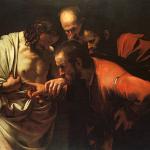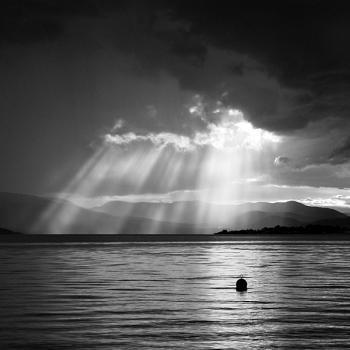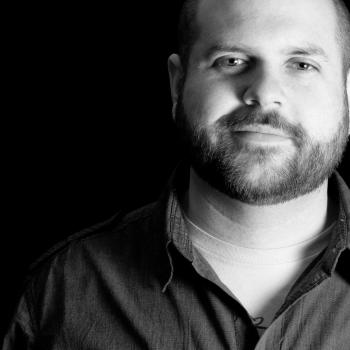You’re a heretic.
I’m a heretic.
She’s a heretic.
He’s a heretic.
Maybe it’s just me, but it seems like you can’t venture into the world of the Christian Internet without avoiding accusations of heresy being lobbed from one theological camp to another.
Branding folks like Brian McLaren or Rob Bell or Rachel Held Evans as heretics as become something of a sad recreational sport with entire websites and “ministries” devoted to seeking out and “exposing false teachers.”
But what is heresy really?
I don’t think most of us really know.
We have this vague notion of false teaching, but more often than not our version of false teaching seems to be little more than opinions that differ from our own. We may be convinced deep in our soul that what is being said is heresy, but the truth is most of us can’t really explain why.
And, no, quoting a Bible verse does not prove someone is a heretic.
On the flip side of things, what about orthodoxy?
The internet is filled with self-appointed champions of orthodoxy and coalitions of the faithful who are convinced that their version of the Christian faith is the very definition of orthodoxy. And so they stand boldly on the front lines in the battle to preserve the true gospel.
Or at least so they claim.
Unless you’re a super theology nerd it can all get pretty confusing and incredibly exhausting really quickly.
While I am one of those super theology nerds with an academic background in both theology and the history of the church, I’m not interested in becoming yet another self-appointed arbiter of the faith. But I thought perhaps I could lend my hand and bring a bit of clarity to the heresy wars by trying to explain as simply as possible what orthodoxy and heresy really are with the naivé hope that maybe, just maybe it might help someone somewhere avoid being burned at the digital stake.
Now, I know the words “orthodoxy” and “heresy” may sound technical and boring, but they’re critically important concepts to all of us who call ourselves Christian, even if we pride ourselves on doctrinal ambivalence. Why? Because for the Church, orthodoxy and heresy aren’t just about right and wrong ways of thinking.
In the Church, we believe that it is our beliefs that shape how we live. And all of us, no matter how theologically disinclined we might be, have deep convictions about how life is best lived.
Again, this post isn’t about defining what those right or wrong ways of living are, but I do want to offer a basic resource for anyone who has found themselves lost in the middle of the heresy wars.
Because this is just a blog post, I will try to keep things as short as possible and, thus, I undoubtably be oversimplifying things that are far more complicated than I might make them sound.
I’m also going to be taking a slightly different approach than what you might be accustomed to. Rather than talking about “what is within the bounds of orthodoxy,” I think it is more helpful to talk about orthodoxy and heresy as polar opposites with lots of space in-between.
Hopefully, that will make sense by the end of this post if it doesn’t already.
But enough with the introduction.
Let’s talk about orthodoxy.
ORTHODOXY
Orthodoxy, as defined by Merriam-Webster, is “a belief or a way of thinking that is accepted as true or correct.”
While that might appear to be a pretty straight-forward definition, there’s a lot going on with that word “accepted.”
Who decides what’s accepted?
How did they decide?
When did they decide?
And who gave them that authority in the first place?
Welcome to the wonderful world of church history.
Ok, I know you probably don’t find it as wonderful as I do, so I’ll skip most of the details and just say this: you can’t understand Christian orthodoxy without knowing something about the history of the Church. The beliefs we’ve come to call orthodoxy didn’t just fall from heaven one day. They developed over time and in particular circumstances that presented particular challenges the Church needed to meet.
Although the Bible was the jumping off point, it quickly became obvious that clarification was needed on the most important issues of faith. So, the leaders of various churches in various areas of the world would, on occasion, come together to sort things out. Out of these meetings, called ecumenical councils, came things like the Nicene Creed and various other doctrinal pronouncements that defined Christian orthodoxy.
But when it comes to that orthodoxy, there are at least 4 critical things to remember.
The most important thing to remember about orthodoxy is that it requires unity, or at least some semblance of a unified group agreeing and defining what their orthodox beliefs will be. Which means if we’re going to talk about universal (or at least near universal) Christian orthodoxy, we have to go back to some time before the year 1054, back before the messy divorce between Eastern and Western Christianity, back when Christianity was something resembling enough of a unified concept that talking about Christian orthodoxy makes sense.
That’s not to say that after the Great Schism of 1054 we all stopped agreeing on basic doctrines. We didn’t. But disunity throws a big wrench in the “accepted” part of orthodoxy. Which means if doctrines weren’t established until say, the 16th or 19th century by a particular denomination or tradition, they are not orthodoxy for the entire Church.
The second important thing to remember is orthodoxy doesn’t work on assumptions.
Rather than lines in the sand, I think it’s best to think about orthodoxy as the foundation of the faith. Because it is the foundation for what we believe and therefore how we live, the church has always found it incredibly important to establish that foundation by writing it down. Which is why creeds were formed and councils convened. They established what is or is not fundamental to the Christian faith. If it wasn’t written down in a creed or conciliar confession, it wasn’t considered a fundamental part of the faith.
But what about the Bible?
Well, that leads us to the third important important thing to remember when it comes to orthodoxy: the Bible alone does not define orthodoxy.
I know that may sound strange and will no doubt enrage the fundamentalists among us, but it’s true.
Now, the Bible is obviously and absolutely both critical and foundational for shaping the orthodoxy of the Church. However, the Bible says a lot things. Sometimes those things are really confusing and other times they sound pretty contradictory. Which is why the Bible requires interpretation.
As we all know all too well, one single verse can be interpreted in a myriad of ways. Some good, some not so much. It was in response to this sort of confusion and disagreement that the first creeds were formed and various Church councils called.
Creeds and councils came about to essentially define what the right interpretation of scripture (and the faith) is in a foundational way. By that I don’t mean they met to decide what each and every Bible verse should mean. Rather, they met to lay the foundation for how scripture in general should be read and, thus, the faith understood.
That foundation, which we call orthodoxy, is intended to properly guide how we read and understand the fundamental message of the Bible. That is why we can have so many competing views or interpretations of foundational issues like the atonement with none or very few of them being actual heresy.
Now, in laying this foundation, it’s also important to understand that those who formed our earliest creeds and convened at the ecumenical councils didn’t believe that they were creating something new. Quite the opposite. The early church fathers and mothers believed they were being led by the Spirit and guided by scripture to reveal the deepest truths of the faith.
In other words, they weren’t inventing new doctrines (and, no, the Trinity was not invented at a church council), they were clarifying the fundamental testimony of scripture.
Finally, given our place in a 21st century Church filled with thousands of denominations and traditions, it’s critically important to remember that there are actually 2 different types of orthodoxy.
The first type of orthodoxy is what I have been describing so far. It’s the type of orthodoxy that was established before 1054 when the one holy Church was still literally one Church (more or less).
Of course, the Church split once again during the Protestant Reformation and in the centuries since Luther, countless new denominations and traditions have formed, each with their own particular doctrines that makes them distinct from other Christian traditions.
In other words, they have their own orthodoxy.
Many, many of the heresy battles we get into stem from this diversity of orthodoxy.
In our zeal to defend the faith, we denounce others as heretics without realizing that we’re actually defending our version of the faith or our denomination’s version of the faith, not the core orthodoxy laid down by the earliest creeds and councils of the Church universal. That doesn’t make our particular theological traditions heresy, necessarily, but it does mean that what makes them distinctive from one another is, by definition, not orthodoxy.
Which also means heresy is not quite as rampant in the Church as many of us have been led to believe.
In fact, it’s actually pretty rare.
But what is heresy anyway?
HERESY
Simply defining heresy as false teaching isn’t very helpful.
For, if I were to say that the form of baptism doesn’t matter, someone in a tradition that insists on full immersion might accuse me of false teaching. However, neither belief is heresy….or orthodoxy.
Real heresy is those beliefs that either reject or stand in explicit conflict with some component of the Church’s (pre-1054) creeds or conciliar confession. Or you might say it’s those beliefs (such as Arianism) that have been explicitly denounced as anathema by an ecumenical council.
If orthodoxy is about establishing the basic foundation for the faith, then heresy requires opposition to that foundation, not simply an interpretation of that foundation that we don’t agree with.
That also means that just because someone interprets the Bible differently, that doesn’t necessarily make them a heretic. We may pride ourselves on our ability to proof-text our enemies to death, but if we insist on branding them heretics, it’s to the creeds and councils we must appeal, not the Bible alone.
Once again, when we do that, we discover that actual heretics in the Church are few and far between. There are certainly some people who oppose parts of, say, the Apostles’ Creed, but not many who do so and still claim to be Christian.
Nevertheless, even if we suspect that someone is teaching or preaching heresy, credibility demands we do the hard work of carefully comparing what they’re saying with the creeds and conciliar confessions of the Church universal before we try to burn them at the stake. Because it’s very likely that what they’re saying isn’t in fact heresy at all. It’s just something we don’t want to agree with.
Which is why heresy is not quite the trump card we want it to be.
And why we need to remember that there’s a lot of room for disagreement in the Christian faith before one ever approaches the threshold of authentic heresy.
THE SPACE IN-BETWEEN
Ok, so we’ve talked about orthodoxy and we’ve talked about heresy.
I want to finish up by talking about the space in-between because I think that’s where many of our beliefs are actually found.
As I said at the beginning, I think it’s helpful to think about orthodoxy and heresy as polar opposites. If we do think about things in that way, then we begin to discover that there is a whole lot of faith going on in the in-between, beliefs that doesn’t rise to the standard of orthodoxy for the entire Church, but neither is it antithetical to the foundational confessions and creeds of the faith.
Simply put, many, many beliefs the are neither orthodoxy nor heresy. Even some of our most deeply held beliefs aren’t actually orthodoxy. That is to say, though they may built upon a solid foundation and thus be orthodox in the sense that they don’t contradict creed or confession, they themselves are not the foundation the Church has established as necessary to the faith.
They fall in the space in-between the foundation of orthodoxy and the limits of heresy.
And therein lies the spark that ignites so many battles in the Church.
Things like creationism vs. evolution, inerrancy or errors, penal substitution or ransom theory, pacifism vs. just war, though foundational to those who adhere to them, they are actually just interpretations of Christian orthodoxy. They are not themselves foundational tenets of the faith.
In other words, orthodoxy professes that God is the maker of heaven and earth and that Jesus died for our salvation, but it does not define how God created or how exactly atonement was made.
So you might say that orthodoxy tells us what Christians must believe, but not how we must believe it.
Unfortunately, as you know all too well, in real life it’s not that easy.
There are a seemingly infinite number of issues and disagreements about what we “must believe” that needlessly lead to accusations of heresy. Which is why if there is to be any hope of a cease-fire in the heresy wars, it won’t come about until we learn to make space for that disagreement and stop trying to hold others to our own tradition’s version of orthodoxy.
That is to say, peace won’t come about until we find the humility to admit that maybe, just maybe our beliefs are just that.
Our beliefs.

 (
(










